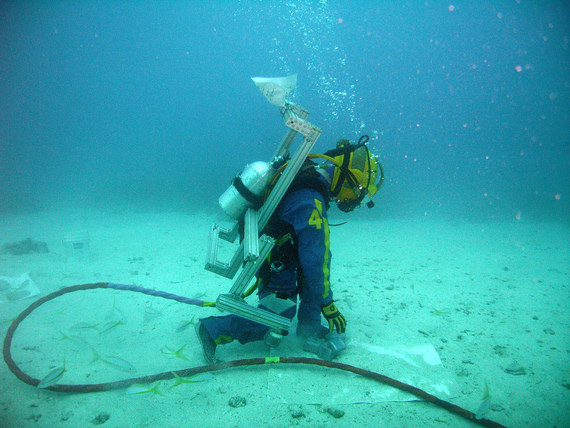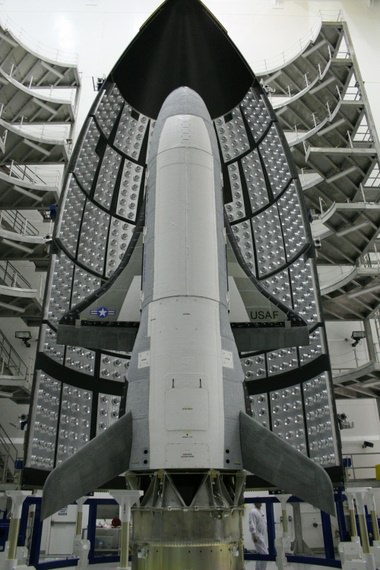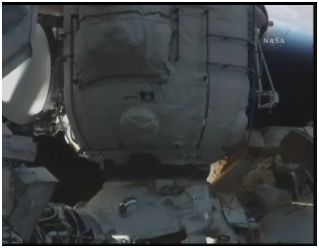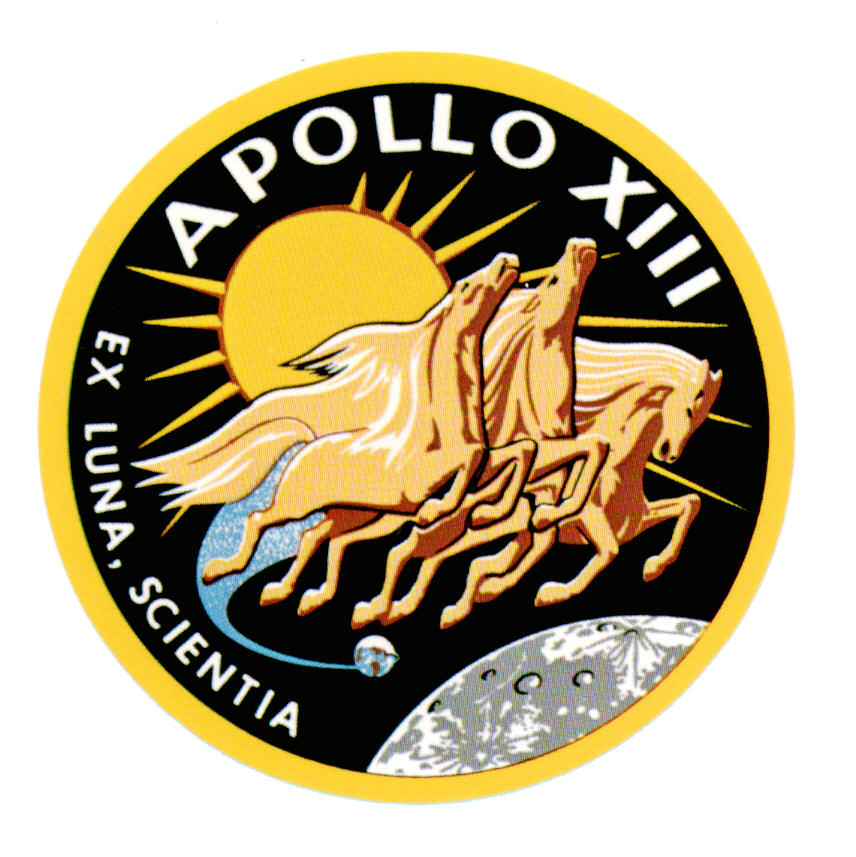A bittersweet moment in space history as Atlantis and her six-member crew landed at Florida’s Kennedy Space Center on Wednesday morning. Very likely, this was Atlantis’ final landing, returning home after 25 years of service. The rich history of the Atlantis space shuttle includes 294 days in space, 4,648 orbits and 120,650,907 miles during 32 flights. There’s a chance this orbiter could fly again – she’ll be readied as a rescue ship for the last scheduled shuttle mission –and many shuttle supporters feel that since Atlantis will be fully geared up, she should fly one last time. But only time (and funding and Congress) will tell if Atlantis will fly again.
Continue reading “Atlantis Returns Home — For the Last Time?”
Finding NEEMO Helps NASA Prepare for the Future
[/caption]
Talking with the astronauts living in the NEEMO habitat – NASA’s Extreme Environment Mission Operations – is a bit like talking with Darth Vader; there’s a regular hiss of air intake and outflow in the background. But the ever-present pastel blue hue in the webcam feed lets you know these astronauts aren’t in space. They are living and working in an underwater habitat, 20 meters (70 feet) under the ocean, just off the coast of Key Largo, Florida. What are NASA astronauts doing under the sea?
“This is the closest thing to spaceflight I’ve ever had in all my NASA training,” astronaut Tom Marshburn told Universe Today in the midst of his 14-day stay in NEEMO. “It is very real. Our lives are completely dependent on our habitat, we have to follow checklists and procedures to be safe, we have to watch out for each other, we’re in a tight confined space and doing real work that will help future space missions. So, in all ways it is much like spaceflight, including having a great view out the window.”
Except in space, there wouldn’t be a giant grouper peering through the portal.
The habitat, called Aquarius, is the world’s only undersea laboratory. Mainly it is used for marine research but NASA has found it has great utility for training crews to live in space. “It’s the closest thing to spaceflight without going to space,” Marshburn said. “We’re able to do operational research, work that is applicable to what we need to know about flying in space. We also do life sciences research and some marine research.”
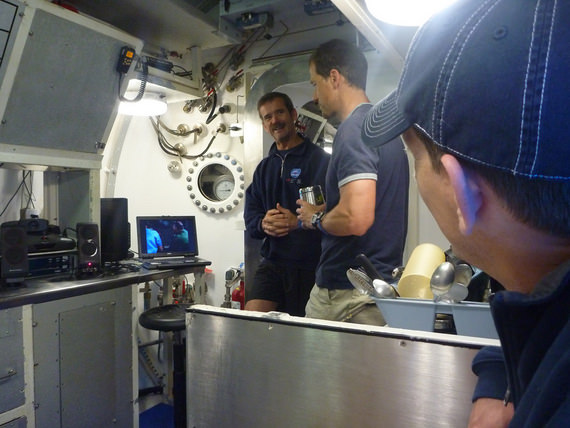
Joining Marshburn is Canadian astronaut Chris Hadfield, who is the commander for this undersea mission, as well as the Lunar Electric Rover Deputy Project Manager Andrew Abercromby and Steve Chappell, a research scientist, along with two technicians.
Aquarius itself is a long cylinder, “like a couple of Winnebagos set end to end,” Marshburn said, with a box-like entry at one end called the Wet Porch.
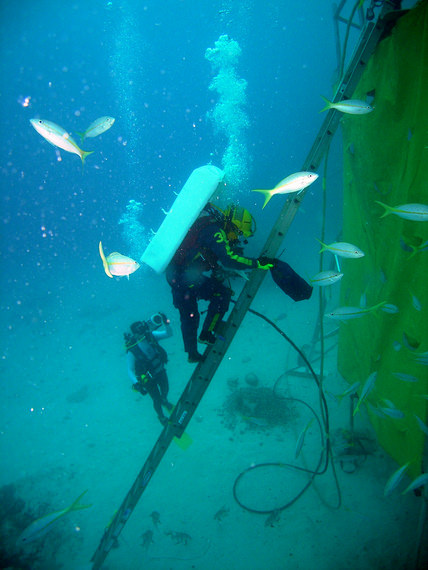
“When we dive into the Wet Porch, there is no hatch. The air pressure keeps the water out. There is cool pneumatic sliding door like something out of Star Trek, and you just walk on in. There’s a galley where we eat backpacking type food, we sleep in a bunk room. There’s six of us in a room about the size of a closet. You get to know your crewmates really well.”
The main working area of Aquarius is filled with valves, dials and lit panels. “It’s a lot like a spaceship,” Marshburn said.
Marshburn and Hadfield are members of the 14th NEEMO crew. The tasks and objectives for their mission, besides giving them training for a long-duration space mission is to do operational research on spacesuits for different gravity and environment requirements (on an asteroid, Mars or on the Moon).
“As you may know, astronauts train underwater in spacesuits, so this is a great place to work on spacesuit design,” said Marshburn, “specifically finding where the center of gravity is and what mobility issues there might be. Instead of just diving in the pool, it turns out we can get a lot more done by being down here and going out with the equipment on the sea floor, and be able to spend hours working on spacesuit design.”
The NEEMO 14 crew is doing intense research on the center of gravity and how that affects the ability to perform standard tasks, and helping spacesuit designers increase range of motion and maintain the comfort level for the astronauts on different planetary surfaces.
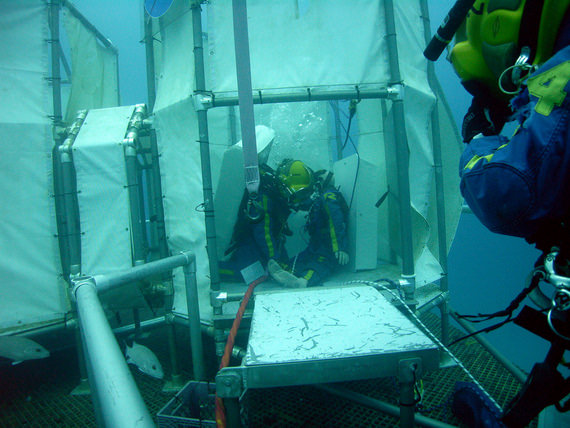
“If we want to explore an asteroid, how do you move around without handholds or something to grab on to?” said Hadfield in a press conference from Aquarius. “Where should the center of mass be for mundane tasks like picking things up or shoveling, or for complex tasks like rescuing a injured crew member? We’re finding that sometimes the center of gravity that is completely wrong on Earth — that would give you a backache in a matter of minutes — works better in a different gravity environment. And that’s what we are trying to figure out. If what we’re finding out is a surprise, that means our simulation is really doing its job.”
The suits can be weighted out to simulate different gravity. The crews do “EVAs” — like spacewalks, going outside every morning and afternoon.
On the ocean floor are also mockups of a lunar rover and lander. Tests for these include hatch design, and ingress and egress simulations. The crew is also doing life sciences experiments, themselves being the subjects. “We’re in a hyper-oxygen environment,” said Marshburn, “that plus living in a confined environment is a lot like living in space and it puts our bodies under stress, so that is being studied, as well as psychological studies. We’re trying to maximize our time down here, so we’re also doing marine geology research.” They also do regular maintenance of the exterior of the habitat.
Marshburn said future designs for spacesuits, rovers, and landers will be based, in part, on what is learned from the NEEMO missions.
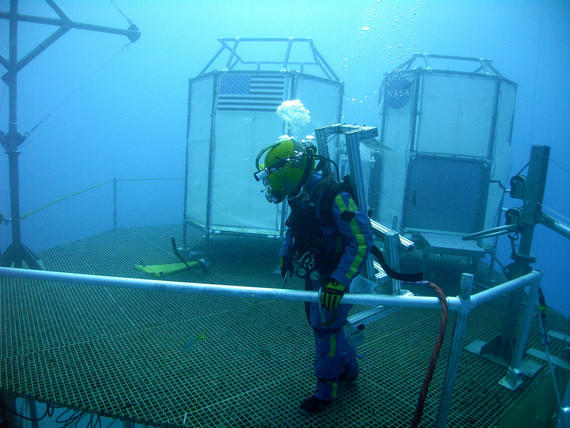
This past week the crew has been in a Mars communication simulation, where there is a 20 minute delay each way for messages – both written and spoken — back and forth from “ground control” on the Earth’s surface. “That has really changed things,” Hadfield said, “it increases our level of isolation. It’s just the six of us with each other with only peripheral help. It forces us to make our own decisions.”
However, the crew has been Twittering during the mission is real-time, an activity Hadfield said he was initially suspicious of. “Twittering was foreign to me, and I only knew it would increase the crew’s work load.”
But what does he think about it now?
“I am delighted with what it has done,” Hadfield said, “not only with our ability to interact with the world, but it forces us to express what we are thinking about. This experience, and the experience of spaceflight is so remarkable that you really shouldn’t horde something that is important to you, or something remarkable that happens. So thousands of people now are following what we are doing down here. This new technology to spread the human experience has allowed us to better articulate to each other, too.”
Hadfield said he is a big proponent of Twitter now, as schools and other organizations have been able to be part of the NEEMO 14 mission.
The mission started on May 10, and the crew will “depressurize” over the weekend to prepare for returning to the surface early next week. It takes at least 16 hours to get the excess oxygen out of their blood. If there would be an emergency, there are backup plans for getting the crew out and keeping them underwater and depressurizing.
Hadfield will be taking a turn on a future long duration space station mission and Marshburn said he is in line for tour of duty on the ISS as well.
“This is best spaceflight simulation I’ve ever had,” he said. “NASA likes to keep their astronauts trained, and believe me, this is worth it. It is very cool.”
Webcams from Aquarius.
Follow NASA_NEEMO on Twitter
See more images from NEEMO 14 on NASA’s Flickr page.
Amazing Time-Lapse Video of Space Shuttle Discovery
UPDATE: Sorry, but the video includes an annoying loud commercial that starts up automatically every time the page loads on UT, but you should really watch this cool video here. Read about it below, though, first!
This is incredible! Smithsonian Air & Space photographers Scott Andrews, Stan Jirman and Philip Scott Andrews created a unique time-lapse video (at the request of shuttle commander Alan Poindexter) from from thousands of individual frames, and they condense six weeks of painstaking work into three minutes, 52 seconds (read here how they did it). The video quickly chronicles the processing of Discovery for the STS-131 mission, and starts at the Orbiter Processing Facility at NASA’s Kennedy Space Center, then goes on to the Vehicle Assembly Building, (the video of how the shuttle is hoisted into a vertical position and lowered onto its external fuel tank is absolutely amazing). Then it’s off to the pad for launch, and you even get to see a quick glimpse of Discovery as it lands. This is the shuttle and mission for which I was able to see much of the processing and pre-launch events, so I found it especially meaningful, but it is even more poignant since the end of the shuttle program is quickly approaching.
What is the Air Force’s Secret X-37B Space Plane Doing in Orbit?
[/caption]
Last month’s launch of the US Air Force X-37B secret mini space plane has fueled speculation about the real mission of this vehicle and if it could possibly be used for a new type of military weapon. The X-37B launched on April 22, 2010 and has the ability to stay in orbit for up to 270 days. While the Air Force provided a webcast of the launch, since then there has been no word — leaked or official – about the status of the mission. “There has been a lot of speculation about what this vehicle could do and what sort of capabilities it could provide to the U.S. military, and some of that speculation was based on more science fiction than fact,” said Brian Weeden from the Secure World Foundation. “While a successful completion of the X-37B flight, landing, and turn-around will certainly be a significant step forward in reusable space vehicle technology, it is a long ways away from a single-stage-to-orbit capability.”
Weeden has put together a fact sheet on the X-37B, looking at the technical feasibility of some of the proposed missions for the mini space shuttle look-alike, and says that there’s almost no chance it could be used as a new weapon or a new weapon delivery system.
The X-37B will land unpiloted at Edwards Air Force Base in California. It uses solar arrays and lithium ion batteries to generate power instead of fuel cells like the space shuttle, a major reason why it can stay on orbit for much longer.
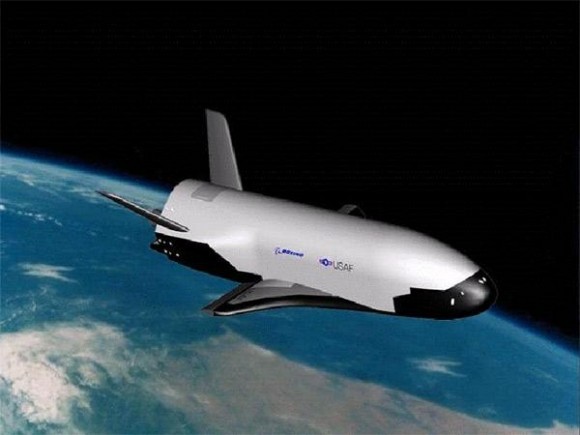
Weeden said that after looking at all the proposed missions for the X-37B, he concluded the most likely probability is that it will be used as a flexible, responsive spacecraft to collect intelligence from space and as a platform to flight test new sensors and satellite hardware.
“One of the downsides to using satellites for collecting intelligence is that once they are launched they have a fixed set of sensors and capabilities,” Weeden said. “The X-37B brings to space the capability to customize the on-board sensor package for a specific mission, similar to what can be done with U.S. reconnaissance aircraft such as the U-2 and SR-71. In many ways, this gives the X-37B the best of both worlds,” he added.
Here’s a brief look at the potential uses for the X-37B:
On-orbit sensor platform and test bed, with the ability to return payload. “What it offers that we have seldom had is the ability to bring back payloads and experiments to examine how well the experiments performed on-orbit,” said Gary Payton, the undersecretary of the Air Force for space programs. “That’s one new thing for us.”
Given the R&D that likely was put into the X-37B, this approach probably isn’t very cost-effective, but Weeden said this is the most likely use the spaceplane. X-37B payload bay could hold various sensors used for intelligence collection of the Earth from space, potentially including radar, optical, infrared, and signals/electronic intelligence suites to flight-test and evaluate new sensors and hardware.
Deployment platform for operationally responsive space satellites. Weeden said this has a midrange chance of being X-37B’s mission, and he quotes Payton: “We could have an X-37 sitting at Vandenberg or at the Cape, and on comparatively short notice, depending on warfighter requirements, we could put a specific payload into the payload bay, launch it up on an Atlas or Delta, and then have it stay in orbit, do the job for the combatant commander, and come back home. And then the next flight, we could have a different payload inside, maybe even for a different combatant commander.”
But given it still would be dependent on the availability of EELV, it may not have a very quick response time for launch.
On-orbit repair vehicle. Weeden said this option has a fairly low chance of being X-37B’s real mission. While it could be used to rendezvous with malfunctioning satellites and repair or refuel them, the X-37B is limited in altitude (it has been rumored that it will have a maximum altitude range of 700 or 800 km (about 500 nautical miles), potentially high enough to access most Sun-synchronous satellites, but this is unconfirmed, plus not many existing operational military satellite components will fit in the X-37B cargo bay. And as the engineers who tried to figure out how to fix the Hubble Space Telescope robotically, without humans, on-orbit repair is extremely difficult, if not impossible.
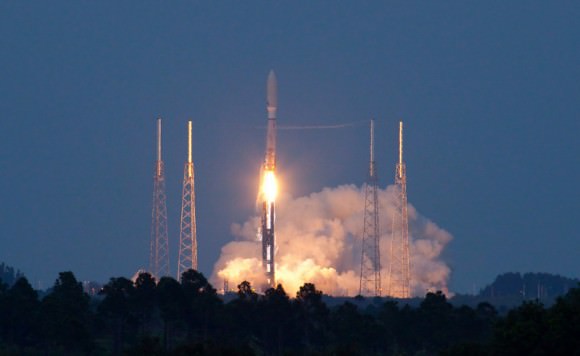
On-orbit inspection of satellites. This option has a low potential, as well. The X-37B could be used to rendezvous and inspect satellites, either friendly or adversary, and potentially grab and de-orbit satellites. However, the X-37B cargo bay is much smaller than many operational satellites, and most of the space in the bay is likely to be filled by the required robotic arm and other gear.
Conventional Prompt Global Strike (CPGS) weapon or delivery system. Weedend says that chance of this being X-37B’s mission is zero. It could be launched in response to a pending crisis and remain on orbit for a length of time to respond to high value/very time sensitive targets. However, since the X-37B re-enters like the space shuttle and lands at an estimated 200 mph (321 kph), this means it travels in the atmosphere much slower than a ballistic arc or a hyperkinetic weapon, so it would need to carry conventional explosives to do any significant damage. Also, after re-entry would be a slow moving, not-very-maneuverable glide bomb, easy prey for any air defense system along its path to the target.
For more information, a four-page, fact-filled X-37B Orbital Test Vehicle Fact Sheet is now available on Secure World Foundation’s website.
Source: Secure World Foundation, special thanks to Leonard David.
Space Station Gets a New Science Module
[/caption]
A 8,550 kg (17,760-pound) Russian Mini-Research Module, known as Rassvet or “Dawn,” was attached to the International Space Station today. This is the first (and last) Russian-built module to be delivered by a space shuttle, and the 8 meter long (20 ft) 2.5 meter (8 ft) diamater module will serve an area for scientific research, as well as for stowage and a docking port extension for future visiting spacecraft such as the Soyuz and Progress resupply vehicles.
“The ISS has grown by one more module,” Moscow mission control radioed up the crew. “We are really very grateful to you. And our congratulations to all of you for this new step in space research and thanks for all your effort and all your work.”
The MRM is packed full of 1,400 kg (3,086 pounds) of NASA equipment and supplies, plus an experiment airlock and European robot arm equipment that will be attached to other modules later.
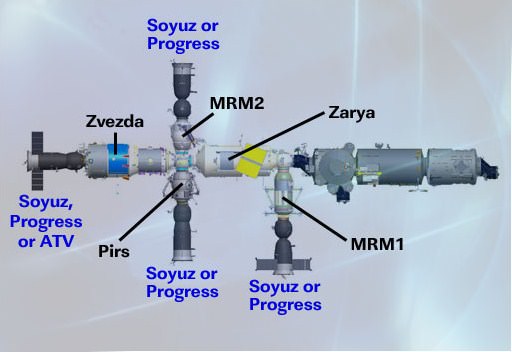
MRM was docked to the Earth-facing port of the central Zarya module, and will provide needed clearance between the forward Russian docking port and a US storage module, the Permanent Logistics Module, scheduled to arrive at the station later this year.
Operations began early this morning to install the MRM, with Atlantis commander Ken Ham and pilot Dominic Antonelli, operating the shuttle’s robot arm to take the new module from the shuttle’s cargo bay. Then astronauts Garrett Reisman and Piers Sellers installed the MRM-1 on Zarya, — appropriately waiting until orbital sunrise to attach the module with great precision. Controllers said Reisman maneuvered the module so precisely, he made a “hole in one.”

Now that the MRM is attached, the ISS and shuttle astronauts now turn their attention to the second spacewalk of the mission scheduled for Wednesday, May 19 to be conducted by Steven Bowen and Michael Good. The primary tasks are the removal and replacement of P6 truss batteries that store solar energy. These batteries have outlived their expected lifespan of 6 years, so the batteries will be swapped out with new ones.
Behind the scenes work has also been ongoing to develop a task to clear a cable that is pinched out on the end of the Atlantis’ boom and sensor system that prevented an inspection of the shuttle’s thermal protection system. NASA TV commentator Kyle Herring said the procedure appears to be a fairly straightforward task to clear the cable out of the way and secure it with a wire-tie. Mission planners are seeing where the procedure fits in best with the rest of the spacewalks tasks.
Atlantis Launch Gallery
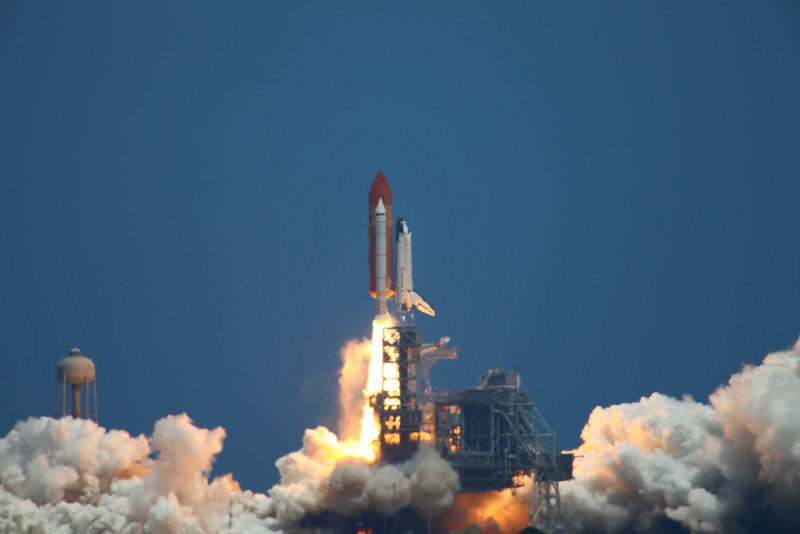
[/caption]
Here’s a gallery of images from the last scheduled launch of space shuttle Atlantis, taken by Universe Today photographer Alan Walters (check out his website!), writer Ken Kremer, and a few from NASA. It was a beautiful day and a beautiful launch. But was it really Atlantis’ last? Only time will tell, but for now enjoy these great images.
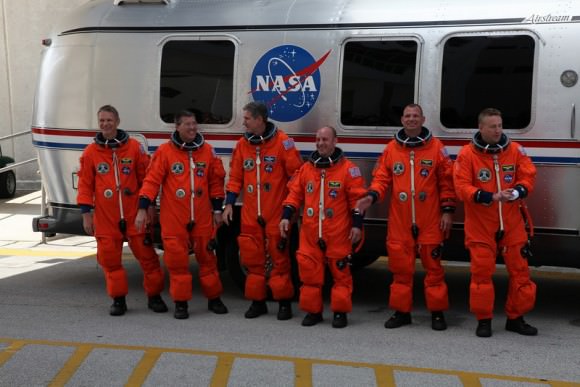
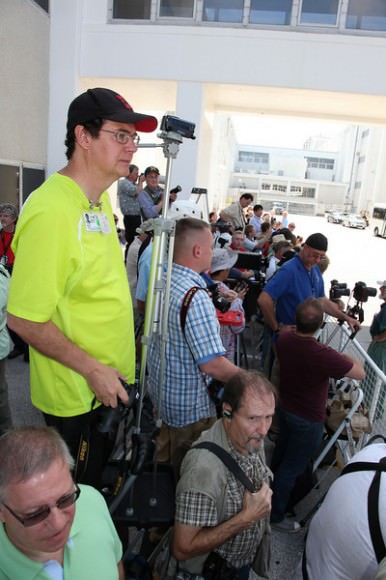
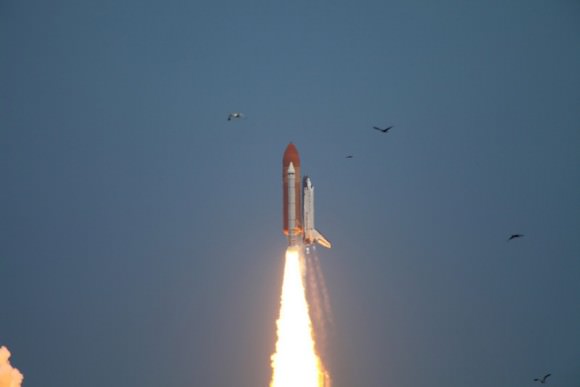
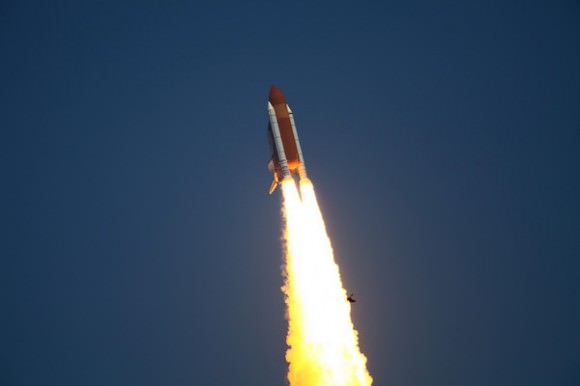
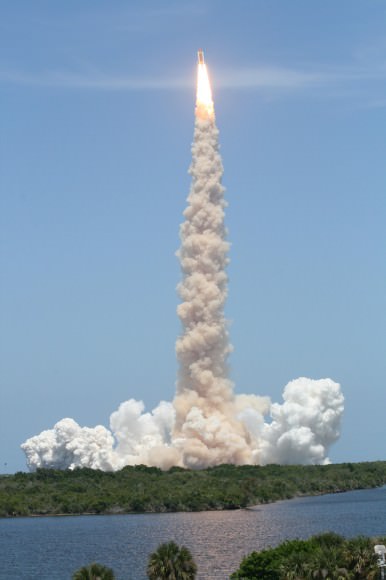
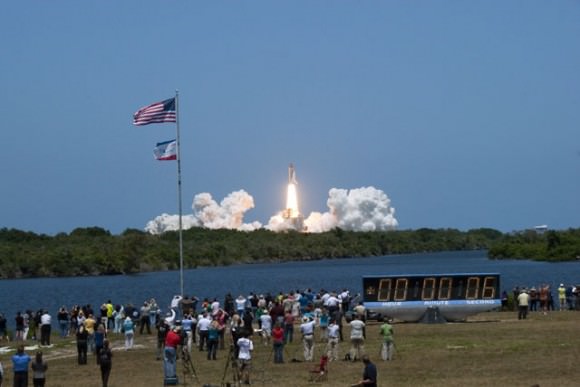
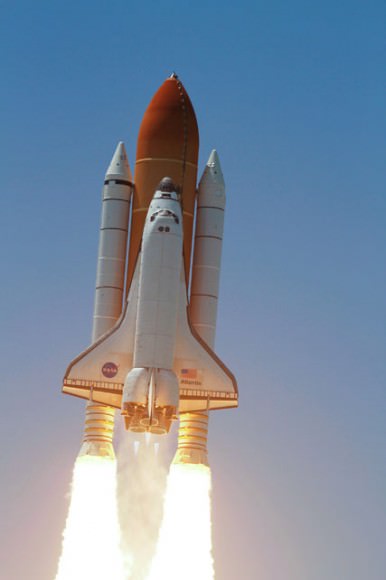
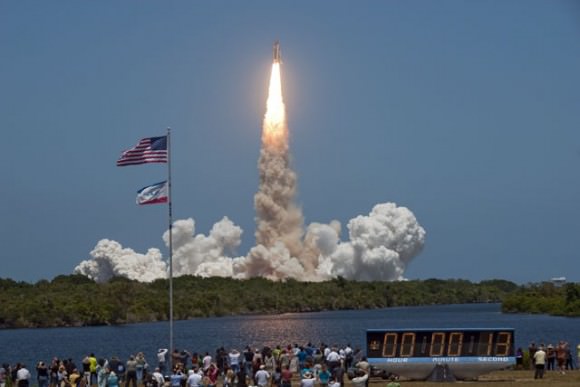
For larger versions of the NASA images, see the STS-132 gallery on NASA’s Human Spaceflight website. We’ll keep you updated on the status of the mission.
The Grand Triumphs and Close Calls of Space Shuttle Atlantis
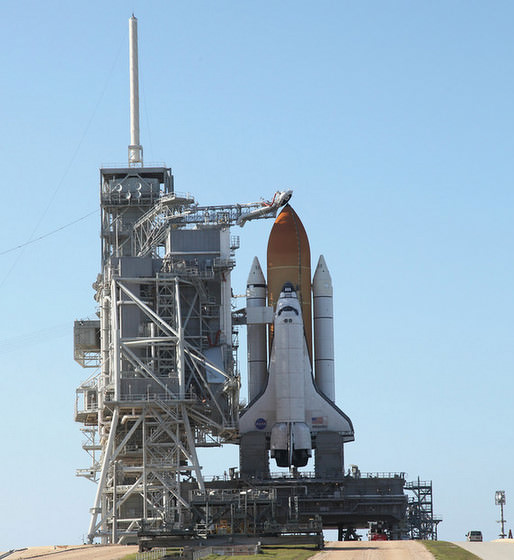
[/caption]
The Atlantis space shuttle now sits poised for her final scheduled flight to space. On this mission, STS-132, Atlantis will bring a veteran six-man crew to the International Space Station to deliver a new Russian science module called Rassvet (Russian for “Dawn.”) Launch is currently set for today, May 14 at 2:20 p.m. EDT (1820 GMT) from Kennedy Space Center.
The Atlantis shuttle is the fourth of the five original shuttles and has pulled her weight in 32 successful launches – compared with 39 for Discovery, and 28 for Columbia, 25 for Endeavour and 10 for Challenger.
In looking back, this mainstay of the shuttle fleet has definitely had her share of highlights and successful missions. But, alarmingly, there have also been some close calls where this orbiter and her crews have teetered on the edge of disaster.
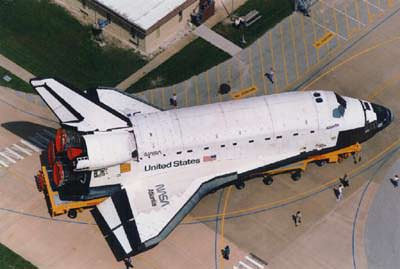
Triumph: Atlantis’ first flight came on October 3, 1985. The STS-51-J flight for the Department of Defense brought a five-man military crew and two DoD communications satellites to space.
Close call: On Atlantis’ next flight, just a month later, STS-61-B, which was the second night launch in the shuttle program, one of the solid rocket boosters experienced primary O-ring erosion in both nozzle joints. There was blow-by of hot gases past the primary O-ring. Post-launch analysis brought the problem to NASA’s attention, but they ignored the issue. Just three months later, an O-ring leak on Challenger destroyed the vehicle and killed the seven-member crew.
Close call: On STS-27 in December, 1988, just the second mission after the Challenger accident, another foreboding of future disaster occurred. 85 seconds after launch, a piece of insulation on the tip of the shuttle’s right-side solid-fuel booster broke away and struck Atlantis’ right side. After the flight, NASA engineers said that while Atlantis had suffered more tile damage than usual, it “wasn’t a major concern.”
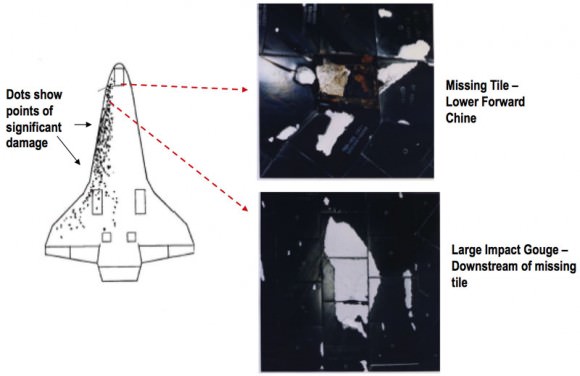
But more than 700 heat shield tiles were damaged, and one tile was completely missing. The metal underneath was partially melted.
The crew knew about some of the damage because of routine heat shield inspections. However, because it was a classified Department of Defense mission, no pictures or television were being downlinked, even to Mission Control. Because there was limited communication between the crew and Houston, the problem was mostly overlooked by NASA officials and the crew actually feared for their lives.
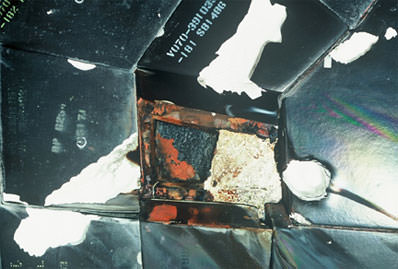
“We had spent all that money and all that time rebuilding and revamping and we launched one successful mission, we [could have] lost the very next one,” said mission commander Robert “Hoot” Gibson in an article by Bill Harwood for Spaceflightnow.com. “I think the Congress would have said OK, that’s the end guys, we just don’t need to do this again. I think that just would have been the end of it.”
But Atlantis returned her crew safely, even with the damaged tiles.

Triumph: Atlantis became a satellite deploying machine! In May and October of 1989, two major interplanetary science missions were launched from Atlantis: Magellan to Venus and Galileo to Jupiter. Then in April 1991, the Compton Gamma Ray Observatory was sent on its mission by an Atlantis crew. Several other satellites launched from Atlantis’ payload bay including more DoD satellites and a Tracking Data Relay Satellite (TDRS-5).
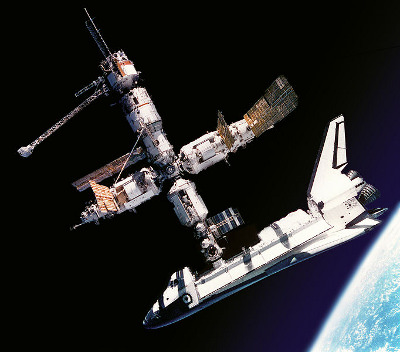
Triumph: In June 1995, Atlantis became the first shuttle to dock with the Russian space station Mir. The STS-71 mission began the first phase of an astronaut-cosmonaut exchange program called the Shuttle – Mir program, which eventually led to the International Space Station program. Atlantis made six more trips to Mir out of nine total by the shuttles.
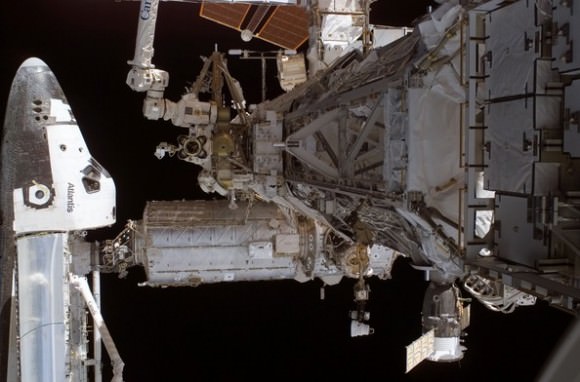
Triumph: Atlantis was a major contributor to the construction of the ISS, and in February 2001 brought the Destiny Lab – one of the major component—to the station This current mission will be Atlantis’ 11th trip to the ISS.

Close call: Rescue ship: Following the Columbia accident, Atlantis was on standby for several rescue flights – called Launch On Need missions, including for the return to flight mission, STS-114. After the Columbia accident, it was recommended that rescue shuttles be on standby which would be mounted to rescue the crew of an orbiter if their vehicle was damaged and deemed unable to make a successful reentry. Atlantis will also be on standby as a LON – designated as STS-335 — for the last shuttle flight.
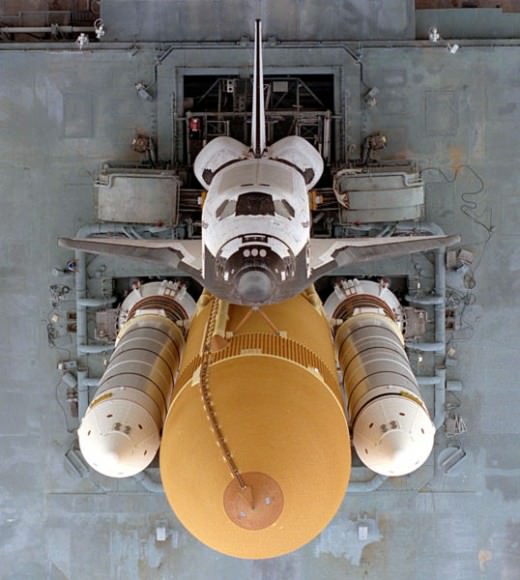
Close call: Atlantis was almost decommissioned. NASA had planned to withdraw Atlantis from service in 2008 to have the shuttle completely overhauled. However, because of the final retirement of the shuttle fleet in 2010, it didn’t make economic sense to do the make-over — what is called the Orbiter Maintenance Down Period. But aging parts needed to be replaced and refurbished, and some critical parts were past their design lifetime. Originally, it was planned that Atlantis would be kept in near flight condition to be used as a parts hulk for Discovery and Endeavour. However, with the significant planned flight schedule up to 2010, NASA engineers found ways to keep Atlantis in flying condition, including a new way of pressurizing helium tanks to reduce the risk of possible rupture. Atlantis was then swapped for one flight of each Discovery and Endeavour.
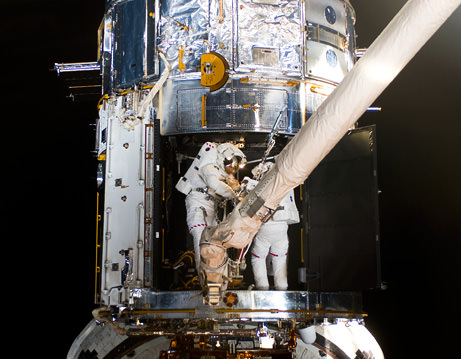
Triumph: May 2009 4th Hubble servicing mission. Atlantis brought the crew of STS-125 to the Hubble Space Telescope for a final mission to refurbish and extend the lifetime of the noble and iconic space telescope. Atlantis’ crew made 5 space walks to do several painstaking repairs, as well as install the Cosmic Origins spectrograph, an instrument designed to allow Hubble to look farther into the universe in the ultraviolet light spectrum than ever before, and Wide Field Camera 3, which allows astronomers to better observe galaxy evolution, dark matter and dark energy. It was such a great mission, IMAX made a movie about it!
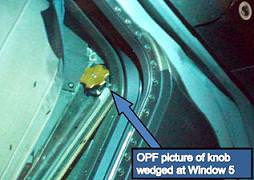
Close call: After the STS-125 mission, a work light knob was discovered jammed in the space between one of Atlantis’s front interior windows and the orbiter dashboard structure. The knob was believed to have entered the space during flight, when the pressurized Orbiter was expanded to its maximum size. Then, once back on Earth, the Orbiter contracted, jamming the knob in place. Engineers determined leaving the knob where it was would be unsafe for flight, and some options for removal (including window replacement) would have included a 6 month delay of Atlantis’s next mission (planned to be STS-129). Had the removal of the knob been unsuccessful, the worst-case scenario is that Atlantis could have been retired from flight, leaving Discovery and Endeavour to complete the manifest alone.
But On 29 June 2009, Atlantis was pressurised to 17 psi/120 kPa which forced the orbiter to expand slightly. The knob was then frozen with dry ice, and was successfully removed.
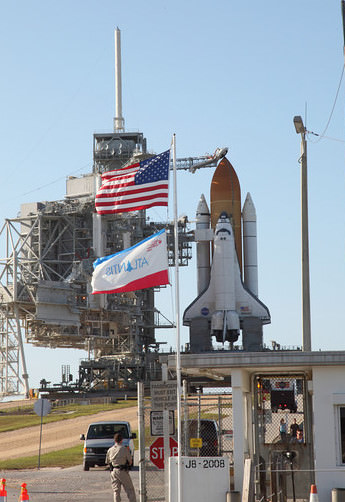
Will there be one – and maybe two more triumphs?
This current mission will be NASA’s 132nd space shuttle flight. But will it be Atlantis’ last? Since Atlantis will serve as the LON rescue shuttle and basically will be ready to fly, some shuttle proponents have said it should fly – why waste a space shuttle that is fully ready to launch to space? Others have proposed an extension of the shuttle program to shorten the gap until the NASA’s next human vehicle –whatever that may be – will be ready. Only time will tell if funds will be appropriated for an additional flight or program extension before the shuttle fleet becomes artifacts in museums.
But Atlantis has stood the test of time and for 25 years has provided many memorable moments.
Godspeed, Atlantis
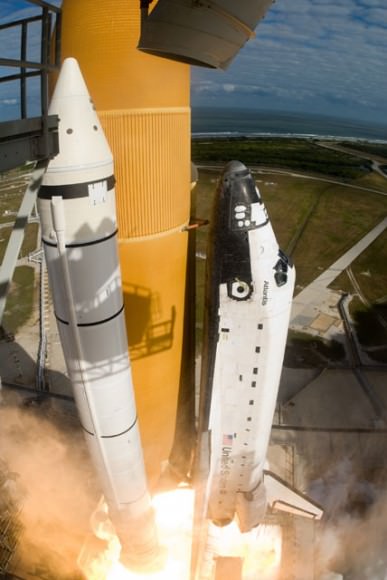
This video aired on NASA TV today, about Atlantis’ legacy:
Another Great “How To Go To the Bathroom in Space” Video
You want details on this subject? Astronaut Mike Massimino has got ’em. The best line in the video comes from Mass: “This is the deepest, darkest secret about spaceflight. People always ask us about UFOs and aliens, and we’ve got nothing for them. But they don’t know about this,” this being that astronauts have a positioning trainer and aligning camera to teach them how to go to the bathroom in space.
Who knew that the terms “docking” and “aligning” have multiple uses in space?
And if you’d like another description, check out our earlier post about astronaut Chris Hadfield’s “best description ever” on going to the bathroom in space.
Successful Test for Orion Launch Abort System
NASA successfully tested the pad abort system developed for the Orion crew vehicle on Thursday morning at the White Sands Missile Range near Las Cruces, New Mexico. The 97-second flight test was the first fully integrated test of the Launch Abort System developed for Orion. “It was a big day for our exploration team,” said Doug Cooke, NASA’s Associate Administrator for Exploration following the test. “It looked flawless from my point of view. This is the first abort system the US has developed since Apollo, but it uses much more advanced technologies. It was a tremendous effort to get to this point, designing such a complex system, and we’ve been working on this for about 4 years. I appreciate the amount of dedication and focus from the team. It was beautiful, a tremendous team effort.”
Continue reading “Successful Test for Orion Launch Abort System”
Your Questions about Apollo 13 Answered by Jerry Woodfill
Now that our series on “13 Things That Saved Apollo 13” is complete, NASA engineer Jerry Woodfill has graciously agreed to answer questions from our readers. We have a lot of questions, so we will post some of Jerry’s answers today and more over the next few days.
Question from Daniel Roy: Did we ever find out why Apollo 13’s trajectory was too shallow on the way back in spite of TCMs? I have trouble believing that the low impulse/ slow venting/ random pointing from ruptured tanks could explain the delta V.
Jerry Woodfill: The shallowing trajectory resulted from the lunar lander’s cooling system discharging vapor during the coast back to Earth. It was not a result of residual release of remnant gases from service module damage. No Apollo mission returned to Earth with a LM attached except for Apollo 13. For that reason the slight but, nevertheless, noticed contribution to the shallowing entry angle had to be dealt with by the Apollo 13 retro. To this day, I find it remarkable that, though the retro did not know the source of the shallowing, he was certain it would cease after the last corrective compensating burn. And, of course it did, after the LEM was jettisoned.
Question from wjwbudro about how much residual power was provided by the fuel cells after the explosion
Jerry Woodfill: Your question about how much residual power the fuel cells contributed prior to employing the emergency (or some call them reenty batteries) launched me into some research about the chemistry of fuel cell operation. I’ve always shared that the reaction of hydrogen and oxygen produce electricity with two by-products extremely useful to human space exploration, breathable oxygen and water. Both oxygen and hydrogen must be present for the reaction to continue.
For Apollo 13, the sequence of the loss of the ability of the fuel cells to produce power relates to the loss of O2 and H2 entering them. Sy Liebergot has a wonderful CDROM where he deals with “how the data read.” Sy had to contend with analyzing what was going on (IN REAL TIME) with regard to the timing of loss of the O2 cryo-tanks, the fuel cells, etc. Google Sy on the Internet, and you’ll find a wealth of information discussing the issue. My admiration of how Sy dealt with such an overwhelming failure so masterfully continues 40 years after the event. But the bottom line is…no O2 into the cells no water, oxygen, or electrical power out. That was the reason for employing the emergency batteries. The fuel cells weren’t much help after because the rupture of the plumbing caused O2 tank One’s O2 to vent into space after O2 tank 2 exploded (I always say “exploded” though some disagree contending it to be a rapid heating of cryogenic O2 being vented into space, sort of like heating air in an empty sealed container until the vessel ruptures.)
Question from science teacher Christopher Becke from Warhill High School: What were the specs of the onboard computers, both in the LM and the Command Module? What was the clock speed and how much (and what type of) memory did they have? I’m trying to impress upon my students that their graphing calculators are more powerful than the computers that brought astronauts to the moon.
Jerry Woodfill: About a year ago, I felt like comparing Apollo 13’s computer to today’s state of the art. Besides the computers (CSM and LM), the only integrated circuit contained among the millions of spacecraft parts was an octal counter in my lunar lander’s caution and warning system’s brain known as the Caution and Warning Electronic Assembly or C&WEA for short. There was an excellent article I discovered at this link from the Download Squad.
Additionally, a wealth of information is given in the Apollo Experience Report which can be accessed at this link.
These documents are a national treasure for recreating the technical history of Apollo. I authored the warning system portion of the Apollo Experience Report on the lunar lander’s Caution and Warning System.
I recall that the strength of the Apollo computer, though it was a “lightweight” in RAM and Hard-Memory, was its “multi-tasking” ability. (Better than an iPhone, since Apple chose not to include that capability presently in mine.) However, when my warning system began to ring “Program Alarms,” (warnings, five of them to be exact) this multitasking capability proved altogether helpful in making Armstrong the first man on the Moon.
One of the Apollo Computer’s “subtasks” was akin to a kind of low level housekeeping info thing which generated an alarm. But the priority executive routine of providing landing control continued undisturbed. Ignoring the program alarms by Flight Controllers Steve Bales and John Garman was a huge reason Neil Armstrong was first on the Moon, that President Kennedy’s prediction and challenge was fulfilled in that decade, and, most importantly, for me…that I didn’t go down in engineering/aerospace infamy whose warning system sounded a “false-alarm” making Pete Conrad and Allan Bean the first men on the Moon on Apollo 12. Thanks Steve and John!
Question from Greg: Should NASA be spending more time reviewing the Apollo 13 mission and other mishaps in order to better anticipate and respond more effectively to new and unexpected mishaps in future missions?
Jerry Woodfill: The neat thing about every one of these questions is they launch potential investigations which can only help future space travelers. Whether it was Apollo One, Apollo 13, Challenger or Columbia, each tragedy resulted in fixing a later situation which might have been fatal if corrective steps had not been taken to learn from failure. This question is one that I’ve addressed extensively in unpublished books I’ve authored.
Now, regarding failure to fix potentially fatal items; yes, over the course of my 45 year career, it is easy to reflect and study failures after the fact and cite instances where people, groups, circumstances resulted in disaster and tragedy. I’m one of those guilty people. I should have done a better job with regard to the Apollo One warning system. Collectively, and, perhaps, individually, we share the burden of not having done a better job for Gus, Roger, and Ed.
Specifically, I remember the final review at North American of Spacecraft 012 where Ed, Gus, and Roger sat at the front of the conference room. They were included with a NASA review panel determining how to disposition “open items” or “squawks” needing fixing before or after shipment of their Apollo One spacecraft to the Cape.
My warning system was a problem for me because it became sort of the “wolf crying boy” who is always the one to aggravate those who want to ignore a root problem blaming it on the messenger. During the initial factory tests of this, the first of the litter of subsequent Apollo Command modules, there were dozens of times the alarm system sounded Master Alarms.
In summary, virtually none were the fault of the alarm system. But, nevertheless, it was blamed until I could find the actual culprit. Some said, “The electronics are simply too sensitive ringing alarms when all that has happened is a momentary switch actuation causing a brief electrical transient which triggers that Master Alarm.”
After dealing with all the culprits, I had only one unexplained alarm remaining. This was the one I was called to present to the board which included Ed, Gus and Roger. “Next item, O2 FLOW unexplained Caution and Warning Alarm.” It was July of 1966. My wife Betty and I had been married less than a month, and here I was dealing with a life-threatening situation.
To digress here, I think the movie APOLLO 13 would have been better served with this event as the opening scene because all the players in the Apollo program were involved. I remember Apollo 7 crewman Walt Cunningham, one of the Apollo One back-up astronauts along with Wally Schirra and Donn Eisele, rooting around in the Spacecraft 012 mockup. Walt emerged with some kind of handle he had accidentally severed from the ship’s interior. Amazed and disgusted, Walt held it up for all to see. Perhaps, that was a precursor for what was to follow?
My explanation was that the O2 Hi alarm was another of those momentary transient things. I shared that nonthreatening events like a routine turning on of the cyclic accumulator demanded added O2 flow into the cabin actuating the alarm. In fact, in route to the Moon, even a urine-dump would cause the O2 flow to increase ringing the alarm. (Later, that was one of my jobs, to indicate in Apollo 11’s check-list that an O2 Hi master alarm could be expected for that reason.) If it was a problem, it would surface once more during Cape testing and be dealt with then. My assessment was accepted by the board.
On January 27th, 1967, Ed, Gus, and Roger were hours into what was called a “plugs-out” test simulating a voyage to the Moon. Suddenly came the call, “We’ve got a fire in here!” In seconds three men perished. When Deke Slayton arrived later and surveyed the interior of Spacecraft 012, he looked up at the alarm panel. The O2 flow hi light was still on. Likely, the ECS (Environmental Control System) should have called for the high flow of Oxygen feeding the fire, but I will never know if it came on before the fire to warn the astronauts to take action. So that is why I cannot “white-wash” this question because it is simply these kinds of events that result in the failures we have experienced over the course of human space flight. Whenever one happens, it is because of people like me who should have done a better job.
Question from Dirk Alan: My question is about the free return trajectory. After rounding the moon, could a spacecraft head back to earth – travel round the earth and head back to the moon? Could it round the moon and head back to earth again and again ? I’m asking if a space station would be feasible in a circumlunar orbit re-supplied now and again with fuel for course corrections to shuttle between the earth and moon?
Jerry Woodfill: The short answer is yes to all of the above. For Apollo 13, the free return trajectory has been much discussed. I’ve often reflected about it, as well. In fact, the first consideration in the rescue was to return to the free return trajectory after the explosion. (BTW, I think I erred in my No. 12 submittal of the “13 Things..” in suggesting that a lander-less-Apollo 13 would have resulted in cremating the crew days later if the explosion had occurred in the circumstance at 55 hours 54 minutes 54 seconds. They were not in the free return mode at that time having departed from it by an earlier burn.)
In actuality, the crew, shortly after the explosion, used the lander’s descent engine to return to free-return. Recently, in conjunction with Apollo 13’s 40th anniversary, added study has been done. The investigation sought to determine how close Apollo 13 would have come to Earth based on its free-return orbit. Here is the link to a YouTube video summarizing the effort. It’s really neat!
Hey, I just listened once more and watched this again. Apparently, I was right predicting the crew without the lander would have been cremated after all, five weeks later in May of 1970. Don’t ascribe this to any talent I have. It’s just lucky. But watching the video will do much to answer every question you have above about space stations, etc. You might Google other terms like Hohmann Transfer Orbit, Aldrin Cycler Orbit, Libration Points, and Sling-Shot orbits. These are strategies in orbital mechanics considered when planning planetary exploration, manned and unmanned.
Questions from Gadi Eidelheit, Quasy and Tom Nicolaides about the Hatch That Would Not Close
Jerry Woodfill: I’ve shared the account of “the hatch that would not close” virtually every time I’ve shared the Apollo 13 story. ( This is approaching a 1000 talks. Do the math. Simply telling the story once a month for nearly 40 years adds up to nearly 500 times.) One man believed the inability to make the hatch close resulted from differential pressure between the vehicles. I tend to discount that because the hatch had been open for some time stabilizing the interior atmospheric pressure throughout the assemblage.
Others who have considered the problem, think that Jack Swigert and Jim Lovell’s belief that a meteor had punctured the LM caused Jack and Jim’s hasty efforts to be flawed and inexact. The misalignment in the hurried closing was responsible. This was addressed in one of the crew debriefs I reviewed several years ago.
Now, I just had the thought, “The Apollo 13 capsule is available at the Kansas Cosmosphere.” To my knowledge, no one since the rescue has actually tried to reproduce the hatch closing problem. But, again, I simply don’t know if that has been the case. (As we press on, I’m going to be honest about what I know and don’t know. This is one of those things I really can’t answer satisfactorily.)
From Hans-Peter Dollhopf: Question about Why an Apollo 13 Movie and not an Apollo 11 Movie:
Jerry Woodfill: Another question I wanted to address among those left at the close of each of the “13 Things…” articles concerns why a movie was made about Apollo 13 and not about Apollo 11. My thought is because of the circumstance of how the movie came into production. I have a close friend named Jerry Bostick. Jerry was the lead FIDO for Apollo 13. We knew one another through the local Methodist Church, too. Jerry’s son Mike was in one of the Sunday school class sessions I taught.
Well, Mike went on to work for Ron Howard as a producer for Universal Studios. Being familiar with the Apollo 13 rescue because his dad, Jerry Bostick, had played a key role, Mike suggested to Ron Howard that Universal buy the rights to Jim Lovell’s book LOST MOON, for a movie. Incidentally, Jerry Bostick is the source of the quote, “Failure is not an option.”
Google Jerry Bostick’s name, and you’ll be able to read the story. Now had Neil Armstrong’s child worked for Ron Howard, and, if Neil had written a book focused on Apollo 11, it might have competed for an academy award like Apollo 13. Incidentally, there are moments in Apollo 11’s mission just as perilous and potentially fatal as the Apollo 11 mission. Perhaps, Nancy will let me address them in another Universe Today series! I can count a half dozen so it won’t be “11 Things That Saved Apollo 11.”
Question: Didn’t the Soviets Plan also use LOR?
Jerry Woodfill: About the Soviet Direct Ascent approach. Prior to the dismantling of the “iron curtain” and the cooling of the “Cold War”, information about Soviet Manned Space endeavors was sketchy. I found, in 1977, that a Soviet rocket scientist had proposed a lunar orbit rendezvous technique in the early days of rocketry, even before Sputnik. Unfortunately, or fortunately, with regard to America’s efforts, his approach was not accepted initially. Earliest Soviet approaches, like America’s, tended toward the Direct Ascent scheme. Probably the same debate ongoing with American lunar planners existed in the Soviet Union.
The simplicity of a single vehicle based on a NOVA class booster led at the onset. Ultimately, perhaps, as Soviets studied America’s choice of LOR, and its LEM offspring, an approach similar to America’s was pursued. Nevertheless, the ultimate Soviet booster N-1 was much more powerful than the Saturn V. (10,000,000 pounds of first stage thrust versus approximately, 7,500,000.)
I was altogether astounded to discover the evolution of the Soviet approach when sketches, and even videos, were released with the collapse of the Soviet Union and its posture of manned space secrecy. But, I still contend, that the early focused efforts by NASA championed by Dr. Houbolt on the LOR lunar architecture won out over, I believe, tardy acceptance by the same in the Soviet Union. One of the finest compliments one receives is the adoption of a competitor’s approach. Simply comparing BURAN to the Space Shuttle tends to make this case as well.
Check back tomorrow for more answers from NASA engineer Jerry Woodfill.

